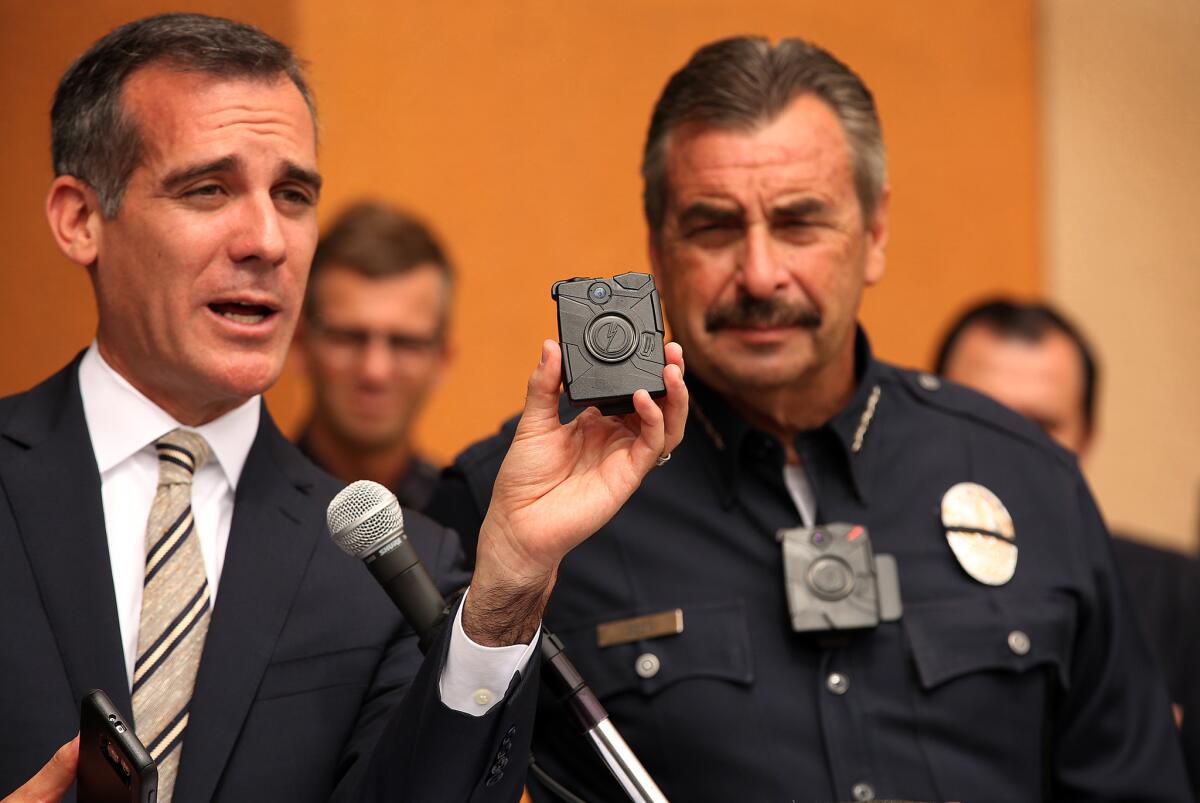LAPD report defends ambitious plan to outfit officers with body cameras

Los Angeles Mayor Eric Garcetti, left, displays a police body camera last year with LAPD Chief Charlie Beck, who is wearing one of the cameras.
- Share via
Los Angeles police officials have formally responded Friday to City Council concerns about the department’s ambitious body camera initiative, arguing that Taser International offered the most suitable devices and video storage when the department first tested body cameras in 2014 and remained the best option during subsequent reviews.
The Los Angeles Police Department has said it looked to “piggyback” off a competitive search used by another agency to save time and avoid the type of contentious, time-consuming bidding fights that have delayed other city efforts.
The department, with the approval of the city attorney, decided to piggyback on Kern County’s bidding process, which the report said included specifications that were “substantially similar to those of the LAPD,” according to a report made public last Friday.
Other, smaller vendors have criticized the department’s choice and piggybacking process, saying they were unfairly passed over despite having body cameras that could work for the LAPD.
The report sought to address lingering questions from several city lawmakers that delayed the council’s December vote on a five-year, $57.6-million plan to put cameras on officers.
The LAPD is one of scores of agencies across the country looking to expand the use of body cameras in the wake of several high-profile killings by officers that generated greater public scrutiny of policing.
The department has already purchased about 860 cameras through privately raised funds, an effort Mayor Eric Garcetti vastly expanded in 2014 by announcing the city would buy roughly 6,000 additional devices, making the LAPD rollout the most extensive in the nation.
But City Hall hit the brakes in December after lawmakers expressed concerns over the project’s price tag, the number of LAPD personnel dedicated to the program and the process by which department officials determined they wanted to buy the cameras from Taser.
NEWSLETTER: Get essential California headlines delivered daily >>
The LAPD’s report -- which will be discussed by police commissioners Tuesday before it is sent to City Hall -- said that although “many new vendors” have emerged after the 2014 high-profile police killing of Michael Brown in Ferguson, Mo., “the majority of those solutions did not meet” the LAPD’s needs.
“The LAPD cannot afford to be the guinea pig for solutions that have not been proven in the law enforcement field, and, in particular, proven in a large-scale deployment,” the report said.
Department officials estimated they would assign nearly 110 sworn officers and civilian staffers to tackle the “large size and scope” of the LAPD’s body and in-car camera programs. Dedicated personnel will be needed to review the footage for a range of investigations and audits, the report said.
The number of videos generated by the cameras so far has been “significant,” the report said. Between August and December, four LAPD divisions that already have body cameras generated more than a quarter-million recordings.
Follow @katemather on Twitter for more LAPD news.
ALSO
Lufthansa jet and drone nearly collide near LAX
Death of high-rise worker in downtown L.A. investigated as possible suicide
How the killing of Latasha Harlins changed South L.A., long before Black Lives Matter
More to Read
Sign up for Essential California
The most important California stories and recommendations in your inbox every morning.
You may occasionally receive promotional content from the Los Angeles Times.














